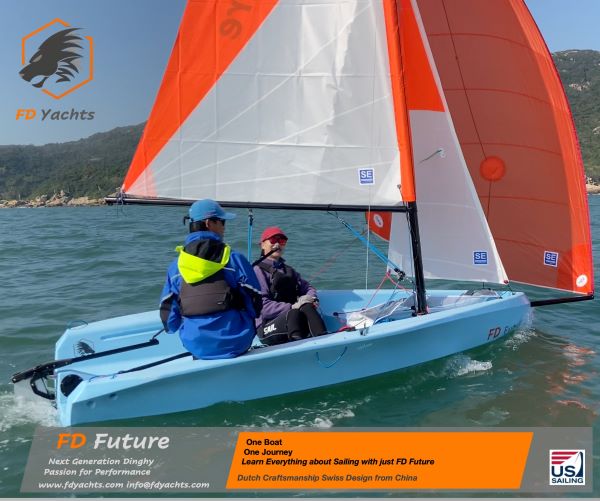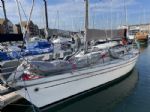












Boats for sale
| Rossiter Pintail Mortagne sur Gironde, near Bordeaux |
 |
| Laser 28 - Excellent example of this great design Hamble le rice |
 |
List classes of boat for sale |
Quiz Question |
Post Reply 
|
Page <1 234 |
| Author | ||
gordon 
Really should get out more 
Joined: 07 Sep 04 Online Status: Offline Posts: 1037 |
 Post Options Post Options
 Quote Quote  Reply Reply
 Topic: Quiz Question Topic: Quiz QuestionPosted: 10 Dec 12 at 9:14pm |
|
|
Thankfully, when umpiring, most rule 15 and 16 penalties that I give do not involve contact.
On the water the fast tack or gybe - when the crew is ready and prepared - is very different from the crash tack or gybe to avoid a collision. The absence of preparation is often a tell tale sign. And, increasingly, we seem to be giving more penalties for breaches of 15 and 16 and far fewer for 10,11,12 and 13. In other words boats, in team racing or match racing, seem to know how to keep clear unless the ROW boat does not give room when acquiring right of way or changing course. Wouldn 't be the first time that there are differences of interpretation between umpires, who view the incident, and judges, who reconstruct the incident. Or, as any rugby fan will know, between sports officials in the northern and southern hemispheres! |
||
|
Gordon
|
||
 |
||
ohFFsake 
Far too distracted from work 
Joined: 04 Sep 08 Location: United Kingdom Online Status: Offline Posts: 219 |
 Post Options Post Options
 Quote Quote  Reply Reply
 Posted: 10 Dec 12 at 9:18pm Posted: 10 Dec 12 at 9:18pm |
|
With the greatest respect, I think there is. In my boat with symmetric spinaker, we typically dead run with the crew sat well to windward with sheet and guy in hand; helm sat well to leeward steering and trimming main. A normal "seamanlike" gybe would involve probably 5 to 10 seconds of prep - crew re-trims spinaker to keep it flying through the gybe, helm moves to centre, cleats main, takes guy and sheet from crew and moves to steering with tiller between knees. Only now would we be in position to gybe in our normal seamanlike manner, and if its windy we'd probably look to pick a moment some time in perhaps the next 10 or 20 seconds when wind / wave conditions make gybing safest. On the other hand, if another boat unexpectedly forced our hand we could gybe immediately from our normal running position in order to avoid a collision. But in light to medium conditions we'd come out of it with spinaker collapsed, crew at risk of getting hit by the boom, possibly sheets tangled etc, and in heavy weather there'd be a very high chance of wiping out. I think "crash gybe" would be a fair description of the latter situation...
|
||
 |
||
gordon 
Really should get out more 
Joined: 07 Sep 04 Online Status: Offline Posts: 1037 |
 Post Options Post Options
 Quote Quote  Reply Reply
 Posted: 10 Dec 12 at 10:35pm Posted: 10 Dec 12 at 10:35pm |
|
|
Maybe Brass would be happier with "unprepared" tack or gybe
|
||
|
Gordon
|
||
 |
||
Brass 
Really should get out more 
Joined: 24 Mar 08 Location: Australia Online Status: Offline Posts: 1151 |
 Post Options Post Options
 Quote Quote  Reply Reply
 Posted: 10 Dec 12 at 10:42pm Posted: 10 Dec 12 at 10:42pm |
|
The answer to your present question lies wholly in rule 14 and is:
What JimC and I are trying to get across is that your list of 'exceptions' is pretty sound, within the imprecise notion of 'exceptions' but that, in terms of coaching sailors in rules or tactics (or worse still, in adjudicting protests), the list is a bit long to learn by heart and there are nuanced different obligations (give room, give mark-room, avoid, not interfere etc) that need to be applied.
|
||
 |
||
Brass 
Really should get out more 
Joined: 24 Mar 08 Location: Australia Online Status: Offline Posts: 1151 |
 Post Options Post Options
 Quote Quote  Reply Reply
 Posted: 10 Dec 12 at 10:56pm Posted: 10 Dec 12 at 10:56pm |
|
Very nice observation about the difference between umpiring and protest hearing.
I would tend to think that MR and TR competitors have a more 'finessed' approach to the on-water rules than many club and keelboat racers, which is likely to shift the balance between keep clear and room to keep clear. In particular, I think MR/TR competitors are likely to hunt up or down much more agressively, but more precisely, than in ordinary fleet racing: the risk/reward balance is better, and it's more part of 'the game'.
I don't think it would be fair to take my opinion as representative of Australian judges: its just an opinion based on the observations as I see them.
Thank you. Yes I would. Infinitely.
My experience is that protest parties who use the term 'crash tack' and 'crash gybe' are usually the ones on the lower side of the 'competent but not expert and sufficient number ' standard.
|
||
 |
||
Brass 
Really should get out more 
Joined: 24 Mar 08 Location: Australia Online Status: Offline Posts: 1151 |
 Post Options Post Options
 Quote Quote  Reply Reply
 Posted: 11 Dec 12 at 3:07am Posted: 11 Dec 12 at 3:07am |
|
I certainly don't want attack Gordon's experience and judgement but I have just trawled through the London Olympics protests. Here's what I found.
There were 12 valid protests initially for breaches of rule 15, 16, or 18. 2 citing rule 15, 5 citing rule 16, and 7 citing rule 18 (there were overlaps with protests involving more than one rule).
Of these 12 cases:
Nine out of ten cases of failing to give room involved contact. Two out of two cases where a protest against a boat alleged to have failed to give room were dismissed did not involve contact.
Most established cases of failing to give room involve contact between boats QED.
Take home lesson for young players:
Edited by Brass - 11 Dec 12 at 4:38am |
||
 |
||
gordon 
Really should get out more 
Joined: 07 Sep 04 Online Status: Offline Posts: 1037 |
 Post Options Post Options
 Quote Quote  Reply Reply
 Posted: 11 Dec 12 at 10:00am Posted: 11 Dec 12 at 10:00am |
|
|
I would conclude that most rule 15 and 16 breaches that do not involove contact are not brought to the protest room! This may well be because, especially at the highest level, competitors avoid the jury room as much as possible when there is the shadow of a doubt about the possible outcome of the result.
I have been at MR events (including evets where the majority of the teams were going to the Olympics)where almost no penalties were given for rules 10-13. The majrity of penalties were for 15 and 16. Good sailors know how to keep clear if they re given room to do so. |
||
|
Gordon
|
||
 |
||
Brass 
Really should get out more 
Joined: 24 Mar 08 Location: Australia Online Status: Offline Posts: 1151 |
 Post Options Post Options
 Quote Quote  Reply Reply
 Posted: 11 Dec 12 at 12:16pm Posted: 11 Dec 12 at 12:16pm |
|
NO protests for breach of rules 15/16 were upheld and nearly ALL those protests resulted in the give way boat being penalised for not keeping clear.
|
||
 |
||
gordon 
Really should get out more 
Joined: 07 Sep 04 Online Status: Offline Posts: 1037 |
 Post Options Post Options
 Quote Quote  Reply Reply
 Posted: 11 Dec 12 at 1:03pm Posted: 11 Dec 12 at 1:03pm |
|
|
I am always wary of stats. The stats from the 7 Olympic cases involving rule 15 and 16 are based only on protests lodged not on breaches of the rules.
I would conclude that the statistics from the Olympics show that competitors have decided that it is not worth bothering protesting for rule 15/16 breaches that do not involve contact. This may be that it is difficult to demonstrate that rules have been broken without contact, or, more likely, that top class competitors are reluctant to risk going to protest when they consider that the result is aleatory. When race officials are able to see the incidents the number of penalties for breaches of rule 15 and 16 increases greatly. This is because race officials on the water can clearly see the difference between a prepared manoeuvre and a manoeuvre forced by the actions of the ROW boat. It may well be that umpires are interpreting the rules slightly more strictly because they are working at events in which the organisers provide the boats. |
||
|
Gordon
|
||
 |
||
sargesail 
Really should get out more 
Joined: 14 Jan 06 Location: United Kingdom Online Status: Offline Posts: 1459 |
 Post Options Post Options
 Quote Quote  Reply Reply
 Posted: 11 Dec 12 at 3:19pm Posted: 11 Dec 12 at 3:19pm |
|
|
I'm with Gordon on that...
And I do sometimes struggle to switch between team racing and fleet racing...the classic example is the TR call that limits hunting by a starboard tacker on the beat (if an immediate alteration of course is required than the STer has infirnged?)...to fleet racing where boats continue to alter course at very close range directly in order to prevent one continuing on a course where one is keeping clear and at a very late stage resulting in a crash change of course. Absolutely no chance of a decision in the room....and you better do that crash tack because every club PC in the world is going to lob the port tacker.
|
||
 |
||
Post Reply 
|
Page <1 234 |
| Forum Jump | Forum Permissions  You cannot post new topics in this forum You cannot reply to topics in this forum You cannot delete your posts in this forum You cannot edit your posts in this forum You cannot create polls in this forum You cannot vote in polls in this forum |
Bulletin Board Software by Web Wiz Forums® version 9.665y
Copyright ©2001-2010 Web Wiz
Change your personal settings, or read our privacy policy
Copyright ©2001-2010 Web Wiz
Change your personal settings, or read our privacy policy











 Printable Version
Printable Version Delicious
Delicious Digg
Digg Facebook
Facebook Furl
Furl Google
Google MySpace
MySpace Newsvine
Newsvine reddit
reddit StumbleUpon
StumbleUpon Twitter
Twitter Windows Live
Windows Live Yahoo Bookmarks
Yahoo Bookmarks Topic Options
Topic Options